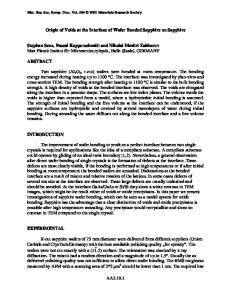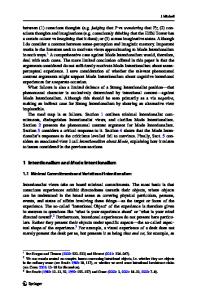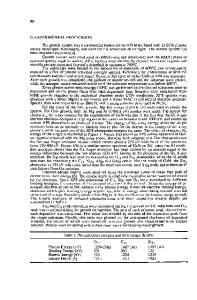Growth Mode at the Ge/(1102) Sapphire Interface
- PDF / 224,970 Bytes
- 6 Pages / 420.48 x 639 pts Page_size
- 16 Downloads / 326 Views
GROWTH MODE AT THE Ge/(li02) SAPPHIRE INTERFACE
GEOFFREY P. MALAFSKY Naval Research Laboratory,
Wash, DC 20375-5000
ABSTRACT
The growth mode of Ge on the (1i02) X-ray
photoelectron
spectroscopy.
Ge
explored with
surface of sapphire is
exists
in
two
bonding
states
at
the
Ge forms islands at submonolayer coverage for
interface, Ge-Ge and Ge-sapphire.
The formation of the islands is
deposition temperatures of 25°C and 625°C. revealed by the rapid increase in
the relative fraction of the Ge-Ge bonding
state for Ge coverage less than 1 ML.
The shift in the Ge-Ge peak binding energy
to the bulk Ge value at less than i
ML suggests
that the islands
are three
dimensional for deposition at 625°C.
I.
Introduction
The
heteroepitaxial
growth
of
Ge
on
sapphire
technological benefits as silicon on sapphire (SOS).
may
offer
the
same
These include lower cross-
talk, latch-up, and parasitic capacitance compared to a device built on a noninsulating substrate
[1].
Single crystal Ge(ll0)
(1102) crystal face of sapphire,
films can be grown on the
but the crystallinity of the epilayer depends
upon the substrate temperature during deposition [2]. Both Ge
[2]
and Si
[3] form islands on the
thicknesses as low as 50 A. growth mode, Typically,
one
must
However,
probe
heteroepitaxy
is
the
in
nucleation
Conversely,
in
of
sapphire surface
deposition
of
the
first
three dimensional
at
the microscopic few
monolayers.
described by the Frank-van der Merwe,
Krastanov, or the Volmer-Weber growth modes [4]. by the
(1i02)
order to determine
Stranski-
The Volmer-Weber mode proceeds
islands
directly
on the substrate.
the Frank-van der Merwe mode the epilayer grows in
a layer-by-
layer fashion. The Stranski-Krastanov model is a combination of the two previous models
with the
first
few
layers
growing
in
a
layer-by-layer
fashion
and
subsequent layers growing via three dimensional islands. This paper describes the interfacial growth of Ge on (1102)
sapphire. X-
ray photoelectron spectroscopy (XPS) is used to monitor the interfacial chemistry
Mat. Res. Soc. Symp. Proc. Vol. 159. ©1990 Materials Research Society
128
for
submonolayer
coverage
of Ge.
The
Ge
deposition
is
performed
at room
temperature (25 - 50°C) and at 625°C.
II. Experimental
The
Ge
films
were
deposited
in
a
UHV molecular
beam
epitaxy
(MBE)
instrument with a base pressure of 5 x 10-11 Torr. The Ge was deposited at a rate of 2-4 A/min with a monolayer of Ge defined to be 1.415 A. After deposition, the sample
was
transferred
under
UHV
to
the
VG
ESCALAB
analysis
chamber
which
contained the XPS system. The photon energy used was 1486.6 eV (Al K ) and the pass energy of the hemispherical analyzer was set to 10 eV. At this pass energy, the FWHM of the Ag 3d 5 / 2 peak from Ag foil
is
collected
sapphire wafers
in
0.1
eV steps.
The 3"
diameter
0.88 eV.
The
XPS
scans were
were
chemically
cleaned [2] and then annealed in vacuum at 1400°C for 30 minutes.
T
Data Loading...











